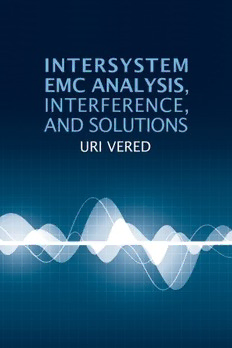Table Of ContentIntersystem EMC Analysis,
Interference, and Solutions
6790_Book.indb 1 4/17/18 3:19 PM
For a complete listing of titles in the
Artech House Elecromagnetics Series
turn to the back of this book.
6790_Book.indb 2 4/17/18 3:19 PM
Intersystem EMC Analysis,
Interference, and Solutions
Uri Vered
artechhouse.com
6790_Book.indb 3 4/17/18 3:19 PM
Library of Congress Cataloging-in-Publication Data
A catalog record for this book is available from the U.S. Library of Congress.
British Library Cataloguing in Publication Data
A catalogue record for this book is available from the British Library.
Cover design by John Gomes
ISBN 13: 978-1-63081-561-5
© 2018 ARTECH HOUSE
685 Canton Street
Norwood, MA 02062
All rights reserved. Printed and bound in the United States of America. No part of this book
may be reproduced or utilized in any form or by any means, electronic or mechanical,
including photocopying, recording, or by any information storage and retrieval system,
without permission in writing from the publisher.
All terms mentioned in this book that are known to be trademarks or service marks
have been appropriately capitalized. Artech House cannot attest to the accuracy of this
information. Use of a term in this book should not be regarded as affecting the validity of any
trademark or service mark.
10 9 8 7 6 5 4 3 2 1
6790_Book.indb 4 4/17/18 3:19 PM
To my editor, Alan M. Egger. This book would not have
reached its quality without his contribution.
6790_Book.indb 5 4/17/18 3:19 PM
6790_Book.indb 6 4/17/18 3:19 PM
Contents
1 Definitions 1
1.1 Introduction 1
1.2 Objectives 1
1.3 Interference 2
1.4 Radio Frequency Interference 2
1.5 Compatibility 3
1.6 EMC and RF Compatibility 3
1.7 Emissions and Susceptibility 3
1.8 The System 3
1.8.1 Definition 3
1.8.2 System Content 4
1.9 External Systems 4
1.9.1 External System Types 4
1.9.2 Definition 5
1.10 Intrasystem and Intersystem Compatibility 5
1.11 Interference to and from the System 5
1.12 One-Way and Two-Way EMC 6
1.13 Electromagnetic Environment 6
1.14 Signal Types 7
1.15 Hierarchy 7
1.16 Device Level 8
1.17 Platform Level 8
1.18 Site Level 8
1.19 Arena Level 9
2 EMC Requirements 11
2.1 Objective 11
2.2 Device Level EMC Requirements 11
2.2.1 Objective 11
2.2.2 The Device EMC Requirement 12
2.2.3 Capability to Comply with the Operational Requirements 12
vii
6790_Book.indb 7 4/17/18 3:19 PM
viii Intersystem EMC Analysis, Interference, and Solutions
2.2.4 Definition Approaches 12
2.3 EMC Requirements Within and Between Platforms 13
2.3.1 EMC Within and Between Platforms 13
2.3.2 Distance Between Platforms 13
2.3.3 Near-Field and Far-Field 13
2.4 EMC Requirements at the Platform Level 14
2.4.1 The Platform EMC Requirement 14
2.4.2 Capability to Comply with the Operational Requirement 14
2.4.3 Inter- and Intra-EMC 14
2.5 EMC Requirements at the Site Level 15
2.5.1 The Site EMC Requirement 15
2.5.2 Inter- and Intra-EMC 15
2.6 EMC Requirements at the Arena Level 15
2.6.1 The Arena EMC Requirement 15
2.6.2 The Near-Far Requirement 16
2.6.3 Inter- and Intra-EMC 16
2.7 System EMC Requirements 16
2.8 Requirements Summary 17
2.9 Relationship to MIL-STD 17
2.10 Maximum Allowed Interference Level 18
2.11 The Performance Criteria 18
2.12 The Affecting Parameter 18
2.13 Gradual Performance Degradation 19
2.14 Interference Threshold 20
2.15 Crash Threshold 20
2.16 Performance Degradation Region 20
2.17 Interference Probability Threshold 20
2.18 Operational Damage Level 21
2.18.1 Nuisances 21
2.18.2 Mission Effectiveness Decreases 21
2.18.3 Mission Failures 21
2.18.4 Safety Risks 21
3 EMC Analysis and Survey 23
3.1 EMC Survey Objectives 23
3.2 Included in the Survey 23
3.3 Required Survey Outcome 24
3.4 The Need for Handling EMC Problems 24
3.5 The S/I Approach 26
3.6 The DES Approach 27
3.7 The Participants in the Interfering Mechanism 28
3.7.1 The Interfering Transmitter 28
3.7.2 The Interfering Medium 29
3.7.3 The Interfered Receiver 29
3.7.4 The Desired Transmitter 29
3.7.5 The Desired Medium 29
3.8 Worst-Case and Least-Worst-Case 30
3.8.1 The Worst-Case Dilemma 30
3.8.2 Least-Worst or Easiest Case 30
6790_Book.indb 8 4/17/18 3:19 PM
Contents ix
3.8.3 Saving Calculation Time 31
3.8.4 Worst-Case Parameters 31
3.9 A Possible Structure for the EMC Survey Report 32
3.9.1 Executive Summary 32
3.9.2 General 32
3.9.3 Methodology 32
3.9.4 Systems in the Analysis 33
3.9.5 Device Data 33
3.9.6 Scenarios 33
3.9.7 Requirements 33
3.9.8 Results 33
3.9.9 Summary and Recommendations 34
3.9.10 Annexes 34
4 Interference Types 35
4.1 Interference Types Criteria 35
4.2 Interfering Device Types 36
4.3 Antenna Lobe Types 36
4.4 Interference Outcome Types 38
4.4.1 Interference—The Desired Signal Is Not Received 38
4.4.2 Sensitivity Degradation by X dB 38
4.4.3 DES 38
4.4.4 False Reception 38
4.4.5 Damage 38
4.4.6 Degradation of Digital Communication 39
4.5 Interference Bandwidth Types 39
4.5.1 Narrowband Interference 39
4.5.2 Broadband Interference 39
4.5.3 Full-band Interference 39
4.6 False Reception 39
4.7 Interference Types According to Their Source 40
4.7.1 Interference from Transmitter and Receiver Parameters 40
4.7.2 Interference from Transmitter Parameters 40
4.7.3 Interference from Receiver Parameters 40
5 Interference from Both Transmitter and Receiver 43
5.1 Transmitter Spectrum 43
5.1.1 Transmitter Spectrum Definition 43
5.1.2 Source of the Interference Phenomenon 46
5.1.3 Calculating FDR 47
5.1.4 The Interference Effects 50
5.1.5 Calculating the Received Interference Level 50
5.2 CCI 52
5.2.1 Definition 52
5.2.2 Source of the Phenomenon, Nonintentional Case 52
5.2.3 Source of the Phenomenon, Intentional Case 52
5.2.4 The Interference Effects 52
5.2.5 Calculating the Received Interference Level 53
6790_Book.indb 9 4/17/18 3:19 PM

